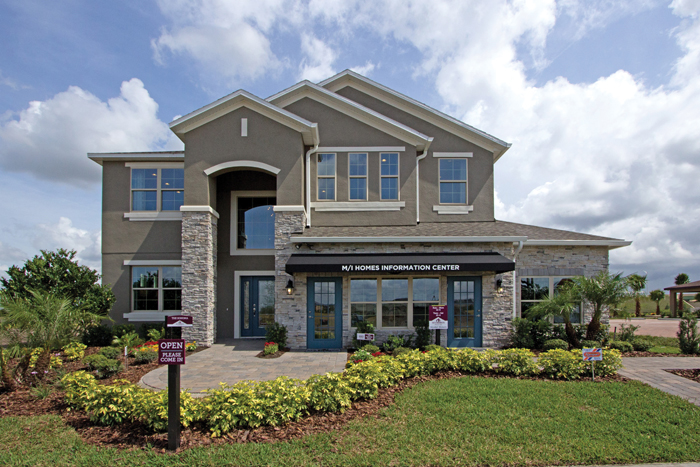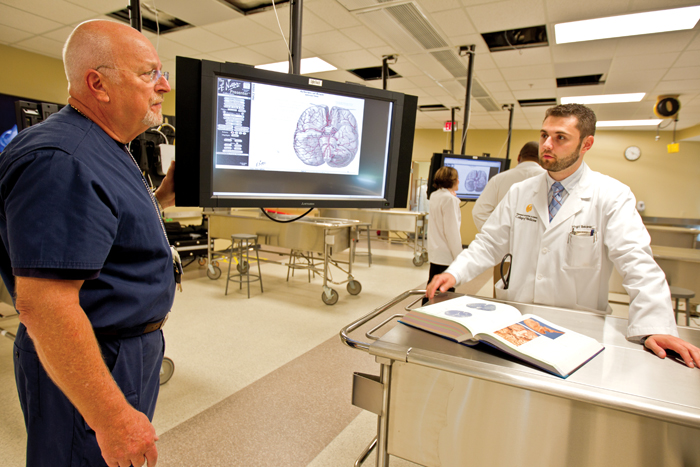
Saying that a community is a great place to “live, work and play” has almost become a cliché these days. But at Lake Nona, it’s not a slogan. It’s an essential aspect of what the community’s all about.
EVOLVING AND INSPIRING
By Dana S. Eagles
An emerging Sports & Performance District is reshaping Lake Nona, bringing world-class athletic facilities to the fast-growing community and taking the health-and-fitness orientation of its Medical City in a new direction.
In January, the USTA National Campus is scheduled to open as the “Home of American Tennis” at Lake Nona, which has about 11,000 people in Orlando’s booming southeast quadrant and boasts the region’s top-selling residential developments.
Billed as the country’s largest tennis facility, the 64-acre campus of the United States Tennis Association will have 102 lighted courts for training and competition, and it will be open to the public.
More than 70 tennis tournaments and other events are planned for 2017 at Lake Nona, which offers easy access to adjacent Orlando International Airport and to State Road 417, part of the beltway around the city.
In spring, the Orlando City Soccer Club is scheduled to open a 23-acre training center. With six practice fields and related buildings, the center will accommodate training for the Orlando City Lions of Major League Soccer, Orlando City B of the United Soccer League, and the club’s Elite Youth Academy.
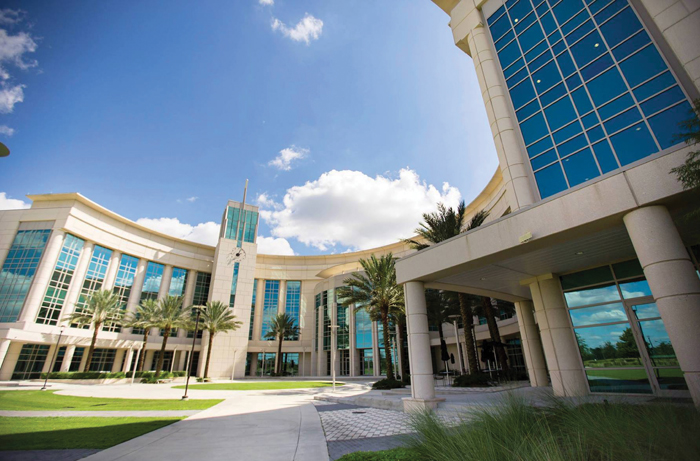
Construction on a four-star resort hotel to serve the sports district is likely to start next year, says Andy Odenbach, vice president of sports ventures for Tavistock, the developer of Lake Nona.
Potential synergies between sports groups and the hospitals, colleges and research institutes of Medical City are a big draw for the new district, Odenbach says, and a significant partnership was announced in May.
Nemours, which operates a children’s hospital in Medical City, said it will partner with the Andrews Institute for Orthopaedics & Sports Medicine, based near Pensacola, to become the official medical providers for the USTA National Campus.
Medical City also includes the Orlando VA Medical Center, the University of Central Florida College of Medicine, Sanford Burnham Prebys Medical Discovery Institute and the University of Florida Research and Academic Center.
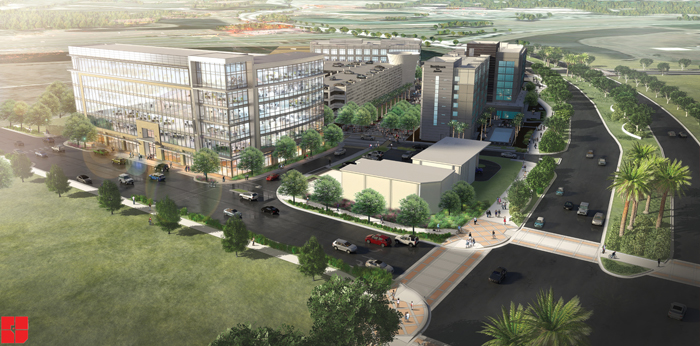
HEALTHY LIVING
Construction of medical and sports facilities makes a big statement, but a concern for healthy living was woven into all of Lake Nona — and it’s evident in more subtle ways, too.
The community ultimately will have 44 miles of trails for walking and biking, for example. And about 40 percent of its 11 square miles will remain undeveloped, creating open space that promotes a sense of well-being.
That still leaves plenty of room for new homes. Rob Adams, vice president of residential development for Tavistock, says 500 homes were sold in Lake Nona in 2015, placing the community among the Top 10 master-planned communities nationwide. About 200 were sold from January through May this year, Adams says.
“There are certain neighborhoods that are built out, but with Laureate Park and Somerset Park, we’ve seen a new spark of growth,” he adds.
Laureate Park, which is next to Medical City, has sold more than 1,060 homes, but is expected to have about 2,600 when complete. That means construction will continue for five to seven years, Adams says.
Conceived as a “wired-in, future-evoking” neighborhood, Laureate Park offers homes in a variety of styles priced from the high $200s. The average price is about $440,000, Adams says, and the typical square footage is about 2,300.
Streets in Laureate Park are named for Nobel Prize winners, and the community offers superfast Internet connections. Yet the transitional architecture of the homes offers a bit of a retro feel. Most of the garages are behind homes, accessible by alleys.
Laureate Park’s Village Center features two pools, a fitness center and the lakeside-dining Canvas Restaurant & Market, with “New American cuisine influenced by Florida’s Southern and Latin American roots.” A new gated subsection of Laureate Park, The Preserve, will offer 151 home priced in the mid-$400s.
Orange County Public Schools is planning a new 800-student elementary school on a 12-acre site in Laureate Park. The as-yet-unnamed school is scheduled to open in August 2017, joining the nearby Lake Nona Middle School and Lake Nona High School.
And an “intelligent home” under construction in Laureate Park will provide a showcase for healthy living when it opens later this year. Although few details about the home have been released, planners are looking at how technology in the home can improve air and water quality, sleep, meal planning and nutrition, says Jessica Jones, project manager for innovation, health and wellness for the Lake Nona Institute, the community’s think tank.
Somerset Park, a gated neighborhood on Lake Nona’s west end, offers more conventional Florida-style homes with garages in front. About 325 homes are planned, about 100 of which have been sold since last year’s opening, Adams says. Prices start around $260,000.
Lake Nona’s VillageWalk, a neighborhood of resort-style homes, was recently built out. But an adjacent development, the 143-site Enclave at VillageWalk, is offering executive homes with an average price in the mid-$800s. Enclave residents have access to VillageWalk’s pool, fitness center and small retail area. About 40 homes have been sold since it opened last April.
For those who prefer to rent, the centrally located Landon House apartments, opening this summer, will offer urban-style studios and one-, two- and three-bedroom units with 10-foot ceilings, gourmet kitchens and a host of fitness amenities. Rents start at $1,120 per month. “We really want to have a broad offering at Lake Nona,” Adams says.
All those new residents need convenient places for shopping and dining — and Tavistock has been busy building them.
The first phase of Lake Nona’s Town Center, near Medical City, is now open with offices and a hotel that has two Marriott brands — Courtyard and Residence Inn — under one roof. A Turkish-themed Bosphorous restaurant is expected to open by year’s end, and a second, gastropub-style eatery is in the works.
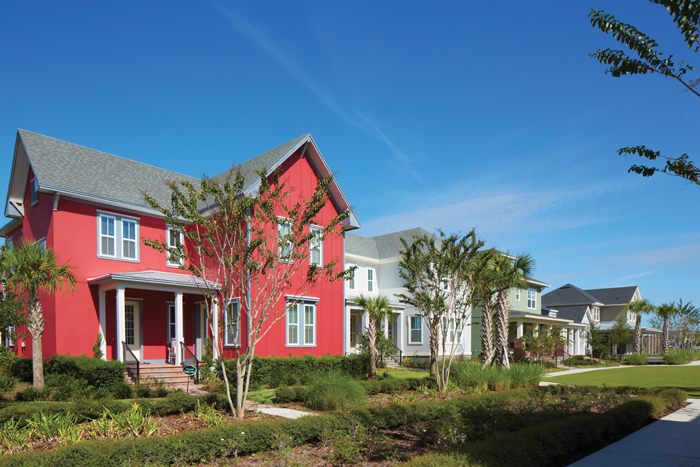
That’s just the beginning, though. Visitors can look out onto a vast, open field behind the Town Center and envision what’s planned for later phases: lots of stores, more restaurants and a movie theater.
The attention that developers paid to the Town Center’s first parking garage — often the crudest type of building — may provide hints of what’s to come.
Outside the garage, a 60-foot-high sculptural steel art installation called The Beacon is wrapped with high-definition video projections that bring it to life at night. Its design was inspired by early stethoscopes.
The Code Wall on the façade of the garage is perforated with the 0’s and 1’s of binary code and adorned with choreographed LED lights and glass panels that reflect sunlight.
When translated, the code spells out the various missions and goals of the Lake Nona community, including the words “inspire,” “participate” and “connect.”
“The Beacon and Code Wall help fulfill our vision of making the Lake Nona Town Center a celebrated gathering place within the community,” says Lake Nona President Jim Zboril.
“We’re taking a parking garage — typically one of the least aesthetically pleasing visual elements of a development — and are turning it into a leading edge, technology-oriented centerpiece.”
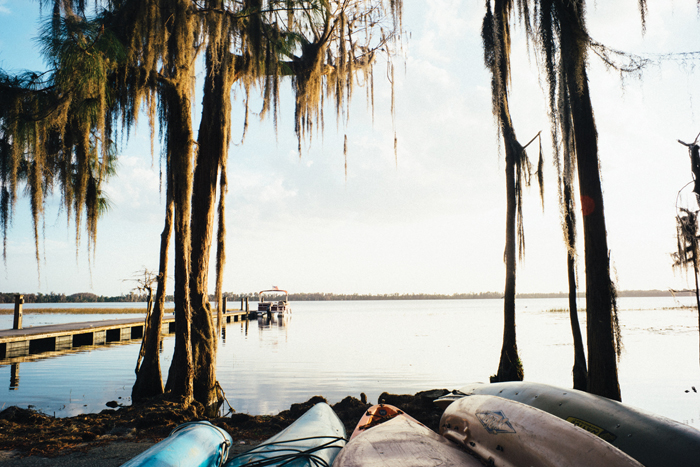
INNOVATION DESTINATION
The Town Center will serve not just Lake Nona residents, but also the thousands of people who work in Medical City, which is also evolving this year.
The last of Medical City’s five major institutions to be completed, the Orlando VA Medical Center, is continuing to open in stages. The hospital, which cost at least $620 million, will have 134 in-patient beds along with a variety of clinics, and an urgent-care facility will become a 24/7 emergency department by the end of the year, says VA spokesman Mike Strickler.
The VA National Simulation Center, scheduled to open in the fall next to the medical center, will train healthcare providers using simulation technology.
Nemours Children’s Hospital will welcome a new neighbor in August. A 22,000-square-foot Ronald McDonald House, adjacent to Nemours and matching its architecture, will give families a place to stay while their children are being treated, with 15 bedrooms and other accommodations. Nemours spokesman Josh Wilson calls the facility “a must-have in a specialty children’s hospital. Undoubtedly, having the family near the child is enormously valuable.”
At press time, Medical City’s first anchor, the Sanford Burnham Prebys Medical Discovery Institute, was negotiating with the state to transfer its Lake Nona assets and operations to the University of Florida, which would merge the institute with UF’s adjacent academic center. Sanford Burnham, which also operates in La Jolla, Calif., has said that because of reductions in federal grants, it can no longer afford to operate the Lake Nona campus, which was built with more than $350 million in state and local incentives.
Medical City’s newest institution, the GuideWell UST Global Innovation Center, recently opened for business. GuideWell, the parent company of Florida Blue, is the ground-floor tenant of the three-story, 92,000-square-foot complex.
The goal, says Chris Hillier, senior director of business innovation for GuideWell, is to “accelerate innovation in the healthcare industry.” Toward that end, the center’s first floor features a Collaborative Resource Ecosystem (CoRE) that provides tools that organizations need to get good ideas to market quickly — from conferencing to 3-D printing to prototyping.
Bill Fair, director of life sciences business development for Tavistock, says the building’s floors are reinforced to accommodate lab equipment, and ceilings are higher to accommodate
ductwork and plumbing.
Although leasing the rest of the building is in the early stages, Fair says he hopes for a “cross-pollination of ideas and best practices” by having for-profit companies and nonprofit organizations come together around the need for rapid change in healthcare.
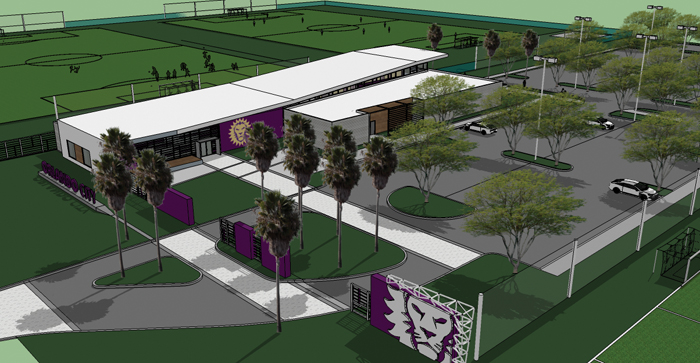
SPORTS CENTER
As the anchor of the emerging sports district, the $70 million USTA National Campus will bring together the association’s Community Tennis and Player Development divisions, along with the Florida branch of USTA and the national training site for USTA-certified officials.
It will be a place dedicated to learning, playing and improving the game. UCF’s varsity tennis programs will make it their home.
“It’s an incredible platform for us to raise the bar for how we deliver tennis,” says Kurt Kamperman, chief executive for community tennis and the USTA National Campus. “We’re using this campus truly as a campus — we want to train people who want to teach tennis, coach high-performance players, organize events.”
Despite its enormous size, the campus won’t be a concrete jungle, Kamperman says. The association had plenty of land to separate courts, while ponds and landscaping will contribute to a parklike setting, he says. Kamperman sees the campus as a “metropolis” with smaller, self-sufficient neighborhoods devoted to different aspects of the game, such as family tennis.
Some of the courts are red clay. The USTA found that the right clay was available only from Cremona, Italy — so it had 450 tons of the stuff shipped to Lake Nona. All the courts will have live streaming, Kamperman says. “So if a 14-year-old from Boston is playing a match and Grandma can’t come, she can watch it,” he adds.
Some courts will have more complex video systems that will help players analyze the strengths and weaknesses of their game.
Nearby, Orlando City Soccer Club is building a $20 million training center while working on a stadium in downtown Orlando. The Lake Nona facility will include a fitness center, clubhouse, locker rooms, offices and rehabilitation center in addition to its six fields. (The Orlando Pride of the National Women’s Soccer League will continue to train at Sylvan Lake in Seminole County.)
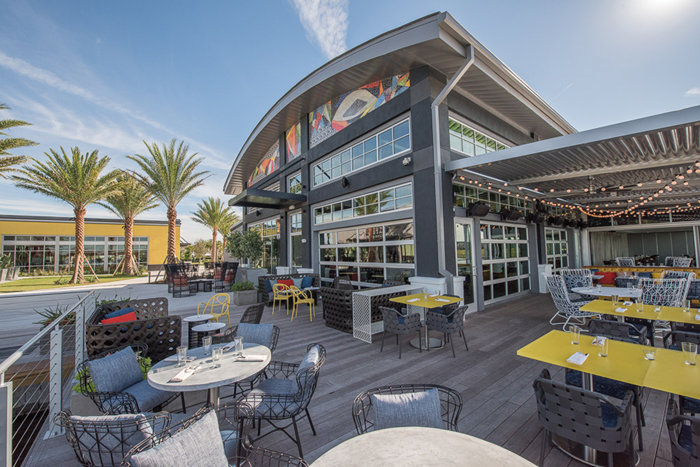
WHY LAKE NONA?
“First, we want to spread our footprint,” says Phil Rawlins, the club’s founder and president. “We like the idea of having multiple bases.”
Convenient access to the airport is also an advantage for the teams, he points out. But Rawlins says that as sports business increases in and around Lake Nona, he also hopes to benefit from sports-performance research likely to take place in Medical City.
“Tavistock is committed to building out a Sports & Performance District. We want to be part of that,” he says. The company is already making room for more sports groups with a 50,000-square-foot office building near the USTA campus.
Odenbach says Lake Nona watchers should expect more announcements about the 200-acre sports district in coming months. Adams and others see the district as a game-changer for current and future Lake Nona residents.
“The USTA campus is really meaningful,” he says. “It’s a public facility, growing the sport of tennis across the board. … It brings tennis to Orlando in a way that was previously unimaginable. With Orlando City soccer, you’ll see it enliven the community. You’ll see a desire to live near the center. You’ll see the faces of Orlando City throughout Lake Nona.”
ABOUT LAKE NONA
Orlando’s Lake Nona is one of the 10 fastest-growing communities in America, with more than $3 billion in residential and commercial construction during the past eight years encompassing 7.1 million square feet. The 11-square-mile, master-planned community is home to a variety of neighborhoods and schools; Medical City; a Sports & Performance District anchored by USTA’s National Campus, known as the “Home of American Tennis”; diverse work spaces; recreational facilities; retail centers and entertainment venues. Lake Nona is committed to sustainable design, healthy living and gigabit, fiber-optic technology. Adjacent to Orlando International Airport, the community is planned for millions of square feet of commercial space, thousands of hotel rooms, more than 25,000 residents and more than 100 shops and restaurants. Lake Nona is being developed by Tavistock Development Co., a diversified real-estate firm owned by Tavistock Group. For more information, visit lakenona.com.
HOMES, SWEET HOMES
The following neighborhoods are within Lake Nona. Unless otherwise indicated, prices are for single-family homes.
• Lake Nona Golf & Country Club. Private sanctuary of luxurious custom homes surrounded by an array of world-class amenities, including a Tom Fazio-designed championship golf course with a clubhouse and lodge. Builders include a selection of the region’s top custom-home professionals. New homes are priced starting at $1 million.
• Laureate Park. Features homes with modern transitional architectural styles and an abundance of intelligent, forward-thinking components. Builders include Ashton Woods Homes, David Weekley Homes, Minto Communities, Craft Homes and Taylor Morrison Homes. Custom-home options are available from Arturo Barcelona Homes, Issa Homes and Phil Kean Designs. New homes are priced starting from the high $200s.
• Somerset Park. Stylish single-family homes in a community featuring such amenities as a community pool and cabana, fountain, playground and walking trails. Builders include M/I Homes and Century Homes. New homes are priced from the $260s.
• Enclave at VillageWalk. Resort-style neighborhood where streets are connected by bridges that form a walkway to the town center, with conveniences such as a café, salon, post office, bank, gas station and fitness center with a full-time activities director. Amenities include six miles of lighted walking trails, two swimming pools, tennis and basketball courts and a fitness center. The builder is Pulte Homes. New homes are priced from the high $500s.
These neighborhoods are in the Lake Nona vicinity:
• Eagle Creek. Master-planned community surrounded by an 18-hole golf course with a manor-style clubhouse. The new Eagle Creek Elementary School is on site. Builders include Jones Homes USA, Toll Brothers and CalAtlantic Homes. New single-family homes are priced from the $300s; golf villas from the $200s.
• Harmony. Nature-themed master-planned community in Osceola County. Builders include Lennar Homes, Regatta Building and Development, CalAtlantic Homes and Richmond American Homes. New homes are priced ranging from the $190s to more than $600,000.
• North Pointe. Homes feature granite countertops and oak or maple cabinetry in kitchens and bathrooms as well as architectural shingles and stucco exteriors in designer colors. Builders include Richmond American Homes. New homes are priced from the mid-$300s.
• Randal Park. 700-acre community that will eventually encompass 815 single-family and 1,400 multifamily homes. More than three miles of bike paths and fitness trails surround a five-acre central park with sports fields. There’s also a community center and eight smaller neighborhood parks and playgrounds. Builders include Mattamy Homes. New single-family homes are priced from the mid-$200s; townhomes from the low $200s.
• Tapestry. Gated, 250-acre master-planned community encompassing 1,100 homesites. Amenities will include a clubhouse, cabana, pool, playground and parks. Builders include Beazer Homes, KB Home and Mattamy Homes. New homes are priced from the low $200s.
Other new-home communities in the Lake Nona area include: Beacon Park Landing (D.R. Horton Homes, from the mid-$200s); Creekstone (KB Home, from the mid-$200s); Overlook at East Park (D.R. Horton Homes, townhomes from mid-$200s); Econ Landing (M/I Homes, townhomes from the low $200s); Gramercy Farms (KB Home, from the low $200s); Hanover Reserve (Royal Oak Homes, from the mid-$200s); Lake Pointe at East Lake Toho (M/I Homes, from the low $400s); and Lake Preserve (Meritage Homes, from the high $200s).
Also: Lakeshore at Narcoossee (Pulte Homes, from the mid-$200s, townhomes from the low $200s); Narcoossee Village (M/I Homes, from the mid-$200s); Live Oak Estates (ICI Homes, from the low $500s); Nova Grove (Meritage Homes, from the high $200s); Oaks at Moss Park (Lennar Homes, from the high $200s); Ravinia (D.R. Horton Homes, townhomes from the mid-$200s); Sawgrass (Beazer Homes, CalAtlantic Homes, KB Home and Taylor Morrison Homes, from the $200s); and Sera Bella (Mattamy Homes, from the mid-$200s).
Finally: Serenity Reserve (55-plus community, from the low $300s); Stonewood Estates (A.R. Bailey Homes, townhomes from the mid-$200s); Storey Park (Lennar Homes, from the mid-$200s); Terra Vista (A&M Homes, from the low $200s); Turtle Creek (D.R. Horton Homes and Dream Finders Homes, from the mid-$200s); Underwood Estates (Royal Oak Homes, from the mid-$300s); Villa Sol (D.R. Horton Homes, from the low $200s); Twin Lakes (55+ community, Jones Homes USA, from the low $200s); Waterside Vista (Park Square Homes, from the low $400s); and Wyndham Lakes (Lennar Homes and ABD Development, single-family homes, from the mid-$200s; townhomes, from the mid-$200s).
HERE’S WHY THEY CALL IT MEDICAL CITY
• Nemours Children’s Hospital. This 100-bed, 630,000-square-foot hospital was built at a cost of $400 million by the internationally recognized Nemours Children’s Health System and opened in 2012. In Florida, Nemours also owns and operates major pediatric specialty-care centers in Jacksonville and Pensacola, 14 pediatric primary-care centers and six pediatric urgent-care centers. In August, a Ronald McDonald House is scheduled to open next to the hospital. It will have 15 bedrooms and other accommodations for families who have sick children being treated at Nemours.
• Sanford Burnham Prebys Medical Discovery Institute. Previously known as the Sanford-Burnham Medical Research Institute, the $85 million, 175,000-square-foot facility opened in 2009 as the first Medical City cornerstone. It encompasses the Diabetes and Obesity Research Center, where scientists focus on metabolic diseases as well as on Alzheimer’s and cancer. The institute’s East Coast campus — the main campus is in La Jolla, Calif. — is also home to the Conrad Prebys Center for Chemical Genomics, where researchers work to identify and develop new medicines. At press time, Sanford Burnham was negotiating with the state to transfer the assets and operations of the Lake Nona campus to the University of Florida.
• University of Central Florida College of Medicine. UCF’s $166 million Health Sciences Campus, which opened in 2010, includes a 170,000-square-foot medical education facility and the 198,000-square-foot Burnett Biomedical Sciences building. In August, when it starts its eighth class, the M.D. program will be at full enrollment — 480 students. It has graduated four classes and awarded 263 M.D. degrees. In addition, the college includes almost 3,000 undergraduate and graduate students in the biomedical sciences, including biotechnology, medical laboratory sciences and molecular biology. The college also opened its second office of UCF Health, its physician practice, last year at Lake Nona. All UCF Health physicians are also College of Medicine faculty members.
• University of Florida Research and Academic Center. The state’s flagship university has built a $53 million, 115,000-square-foot facility that houses a clinical research unit of its Institute on Aging — a program that studies, among other things, drug interactions in the elderly — as well as the Orlando campus of the UF College of Pharmacy. The emphasis is on clinical research related to diabetes and cardiovascular disease as well as obesity. Through the UF Institute of Therapeutic Innovation, also at Lake Nona, researchers are conducting trials to help develop new anti-infectious disease drugs.
• Orlando VA Medical Center at Lake Nona. This 1.2-million-square-foot Veterans Administration hospital and clinic was dedicated in May 2015 and continues to open in stages. The facility, which cost at least $620 million, includes an expanded veterans clinic, a diagnostic and testing center, a 120-bed Community Living Center, a 60-bed Domiciliary and an urgent-care facility. The 134-bed in-patient hospital is opening progressively throughout 2016, and the urgent-care facility will become a 24/7 emergency department by the end of the year. The VA National Simulation Center, scheduled to open this fall near the medical center, will train healthcare providers using the latest in simulation technology. The medical center is also home to the Central Florida Veterans Memorial Park, a $3 million memorial built with donations. The campus will employ approximately 3,000 healthcare providers and support staff, and is expected to serve more than 125,000 veterans in Central Florida.
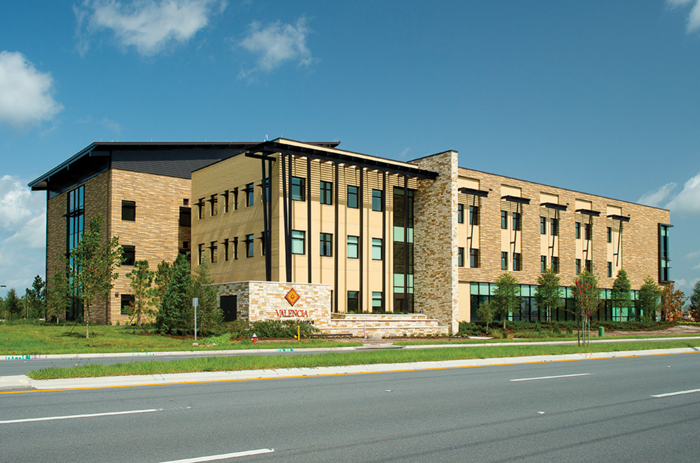
VALENCIA’S SMARTEST CAMPUS
Valencia College’s Lake Nona campus, which opened in 2012, is an ideal place to train for careers in the life sciences. After all, it’s located in the heart of one of the country’s most dynamic biomedical clusters. The three-story, 83,000-square-foot building replaced shared space at nearby Lake Nona High School, and about 400 students at the high school take college classes through Valencia’s dual-enrollment program. Eventually, the campus will consist of four buildings. There are 18 “smart” classrooms, six science labs — including a biotech lab — a library, a bookstore, a small café and student services offices. Sitting areas are designed to encourage studying in groups, catching up with friends or just contemplating the third-floor view of Lake Whippoorwill. Students can earn traditional associate degrees at the Lake Nona campus, but the primary focus is on math and science. Valencia offers a new Associate in Science degree in biotechnology, and programs in physical and occupational therapy are also planned. Built at a cost of $21.7 million, the Lake Nona campus boasts such environmentally friendly features as energy-saving lights and air conditioning, reflective roofing materials and native landscaping that requires little piped irrigation.
MILESTONES
MAY 2009 — Sanford-Burnham Medical Research Institute opens its East Coast facility at Lake Nona. Cost, $85 million; size, 175,000 square feet; projected staff, about 300. In 2015, the institute is renamed Sanford Burnham Prebys Medical Discovery Institute.
AUGUST 2010 — The UCF College of Medicine opens a 50-acre Health Sciences campus. Cost, $166 million; size, 368,000 square feet; staff, 400.
JANUARY 2012 — UCF trustees vote unanimously to purchase 25 acres in Medical City near the UCF College of Medicine for a future teaching hospital and clinic.
AUGUST 2012 — The University of Florida Research and Academic Center, which houses the Orlando campus of UF’s pharmacy program and its drug development center, opens. Cost, $53 million; size, 115,000 square feet; staff, 120.
OCTOBER 2012 — Nemours Children’s Hospital opens and begins accepting patients. Cost, $400 million; size, 630,000 square feet; staff, 1,000.
MAY 2013 — The charter class of students at the UCF College of Medicine graduates. The 36 new doctors all had received full-ride, four-year scholarships courtesy of community donors.
APRIL 2015 — The United States Tennis Association breaks ground on the USTA National Campus, the “Home of American Tennis,” in the Lake Nona Sports & Performance District. It will feature 102 lighted courts and accommodate the association’s Community Tennis and Player Development divisions, along with its Florida branch and training for USTA-certified officials. Cost, $70 million; size, 64 acres; staff, about 200. Opening is planned for early 2017, and about 70 events are expected that year.
MAY 2015 — The Veterans Administration dedicates the Orlando VA Medical Center at Lake Nona, which will serve veterans throughout Central Florida. In addition to a 134-bed in-patient hospital, the complex will include a clinic, a diagnostic and testing center, a 120-bed Community Living Center, a 60-bed domiciliary and an emergency department, which is expected to open in late 2016. Cost: at least $620 million; size, 1.2 million square feet; staff, about 3,000 at completion. The center will continue to open in stages during 2016.
JANUARY 2016 — The Orlando City Soccer Club announces plans to build a 23-acre training facility at the Lake Nona Sports & Performance District. The $20 million training center, scheduled to open in spring 2017, will have six fields, a fitness center, clubhouse, locker rooms, offices and rehabilitation center. It will provide training for the Orlando City Lions (Major League Soccer); Orlando City B (United Soccer League); and the club’s Elite Youth Academy.
EARLY 2016 — The Lake Nona Town Center and GuideWell USB Global Innovation Center open. The first phase of the Town Center features offices, retail space, restaurants and a parking garage adjacent to Medical City. The three-story GuideWell building, named for its anchor tenant, provides office, laboratory and collaborative space at Medical City for life sciences, health innovation and technology companies.

